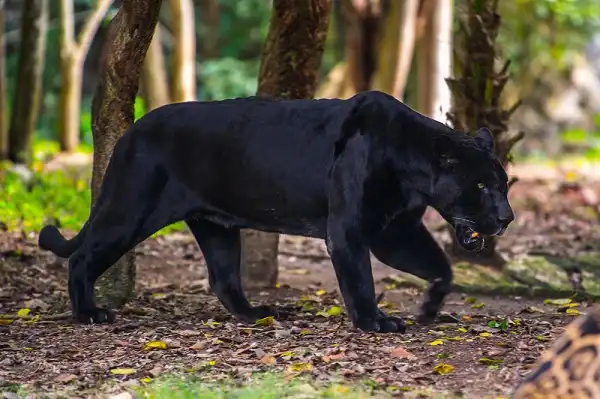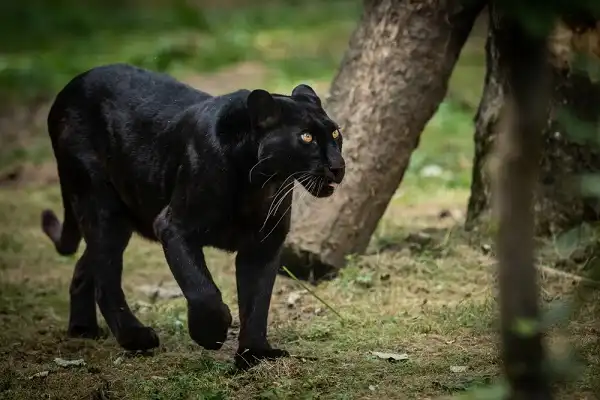The panther, also known as the black panther, is one of nature’s most fascinating and elusive creatures. As striking as they are powerful animals, they have an unmistakable ferocity that captures our imaginations instantly and offers a glimpse into a wilder world of beauty – yet often leads to misconceptions regarding one of the planet’s top predators. In this blog post, we will explore more about what makes this big cat so special and worthy of admiration from across the world.

Panther Description
The panther has a powerful, muscular body that is covered in sleek black fur. Its vibrant yellow eyes pierce the darkness and help it to see its prey in the night. The impressive size of a panther’s head and jaw also enables it to capture prey with ease. A panther can also move quickly and silently through the trees thanks to its long legs and expertly adapted claws. Panthers have four legs, short tails, and rounded ears as part of their anatomy. They tend to live alone or in small groups, preferring areas with dense vegetation for cover. Panther habitats range from tropical rainforests to mountainous regions, though they are most commonly found in wooded areas with plentiful sources of water nearby. Aside from their striking coloration, panthers are distinguished by their “rosette” spots that dot their coats in circular patterns. This unique coloring helps them blend into the shadows and hide from potential predators such as wolves or bears.
Panther Habitat
Panthers inhabit a wide range of environments, from tropical rainforests and dry desert landscapes to dense woodlands and grasslands. They are found in countries across the Americas, Africa, Asia, and Europe. Panther habitats consist of areas with plenty of cover for hunting and resting, including thick forests with abundant prey populations. They also require sources of water nearby such as rivers or streams. During the day they prefer to rest in tree hollows or dense brush piles where they are well-camouflaged by their black coats. Panthers are highly adaptable creatures that have been able to thrive even with the advent of human activity encroaching on their natural environment. Their declining populations due to poaching and habitat loss is a major concern today; fortunately, there are many conservation efforts in place aimed at protecting these majestic big cats for future generations to admire!
Panther Diet
The panther is an apex predator that has a varied diet, depending on what prey is available in its environment. They primarily feed on medium-sized animals such as deer, wild boar, raccoons, and birds. However, they have no qualms about feeding on larger animals such as sheep or cattle if necessary. Panthers also occasionally eat fruits and carrion from other dead animals to supplement their diets. Panthers prefer hunting at night due to their keen eyesight which helps them spot potential prey more easily in the dark. They use their powerful jaws and sharp claws to capture prey quickly and efficiently before dragging it away into dense vegetation or trees. Panthers can also survive for long periods of time without food by reducing their activity levels and conserving energy until they find a suitable meal. This is an important adaptation that enables them to survive in harsh conditions where food may be scarce.

Panther Size
Panthers are large cats that can reach lengths of up to 5-6 feet (1.5-1.8 m) and weigh up to 180 pounds (82 kg). They have powerful, muscular bodies with silky black fur that is covered in distinctive circular “rosette” spots. These spots help them blend into their environment and remain hidden from predators. Panthers also have four legs, short tails, and rounded ears as part of their anatomy. In addition to being large cats, panthers are also incredibly strong and agile; they can move quickly through the trees due to their impressive leg muscles and sharp claws. Furthermore, they have excellent night vision which allows them to easily spot potential prey for hunting after dark.
Panther Lifespan
Panthers have a relatively short lifespan compared to other cats. The average panther lives between 12 and 15 years in the wild, while those in captivity may live up to 20 years. This can vary depending on the availability of prey and the general health of the environment they inhabit. Panthers mature quickly and reach sexual maturity at around 2 to 3 years of age. Panthers experience several stages of life throughout their relatively short lifespan. They start out as cubs, which are dependent on their mothers for food and protection until they are old enough to leave her care at around 18 months. After this point, they become independent adults who must hunt and fend for themselves in order to survive. Panthers are known for their strength, agility, and remarkable ability to adapt – traits that enable them to thrive despite human encroachment on their natural habitats.
Panther Behavior
Panthers are solitary and highly territorial creatures that will actively defend their territories from any intruders. Male panthers typically have larger territories than females, which may span up to 75 square miles (190 km2) in some cases. They communicate through a variety of vocalizations, scent marking, and visual displays such as hissing or snarling to ward off possible threats. Besides hunting for food, panthers also engage in play behavior with each other. This is especially common between cubs who may “wrestle” and chase each other around as part of learning social behaviors that will be important later in life. Adult panthers also enjoy playing; while they may not interact physically as cubs do, they can be seen rubbing against trees to leave scent marks or chasing small objects such as leaves that blow by. Overall, panthers are incredibly intelligent animals with complex behaviors that allow them to adapt even despite human encroachment on their natural environment. Through conservation efforts, we can ensure these majestic big cats continue to thrive for future generations!

Panther Speed
Panthers are incredibly fast and agile creatures, capable of reaching speeds of up to 30 mph (48 km/h) while running. This is a result of their powerful leg muscles combined with their long stride length; they can cover up to 20 feet (6 meters) in a single bound. In addition, panthers have the ability to quickly change direction with ease as they move through their environment. This impressive speed helps them catch prey easily, as well as escape from potential predators. It also enables them to remain hidden from danger; if a panther perceives that it is in danger, it will move quickly away from risk and hide in dense vegetation or trees until the threat has passed. The speed of a panther is not only essential for hunting and surviving in the wild but also an adaptation that allows them to survive in harsh conditions where food sources can be scarce. This helps them stay active and conserve energy during times when food may be difficult to find.
Panther Hunting
Panthers are efficient and deadly hunters, relying on their speed, agility, and sharp senses to locate and catch prey. They primarily hunt at night when they can take advantage of their superior night vision to spot potential targets in the darkness. Panthers have been known to hunt a variety of animals including deer, wild boar, fish, reptiles, and birds. When hunting large prey such as deer or boar, panthers will stalk them for long periods of time before making their move. They use the element of surprise to ambush the animal before using their powerful claws and jaws to kill it quickly. Once the prey is subdued, panthers will drag it into a secure area where they can consume it without interruption or fear of attack from other predators. In addition to hunting large game, panthers also rely on small animals such as rodents or insects as an important food source. They have even been known to scavenge carrion left behind by other animals in order to supplement their diets.
Panther Reproduction
Panther reproduction is typically seasonal, with mating taking place during the summer months. Females enter estrus for a few days each month but are only receptive to males for a brief period of time. Once mated, male panthers will remain in close proximity to the female until she gives birth, protecting her and their cubs from potential danger. Females typically give birth to two to three cubs after a gestation period of about three months. The cubs are born blind and helpless, weighing between 12-20 ounces (340-570 grams).
They will stay with their mother for 18-24 months while she nurtures them and teaches them how to hunt and survive on their own. During this stage, they will also develop their distinctive black coats and rosette spots that help them blend into the environment for camouflage when hunting. Once the cubs have reached independence at around 18 months old, they disperse from their mother’s territory and establish new territories of their own; however, some cubs may remain with their mothers for longer periods of time or even join other panthers’ social groups in order to increase their chances of survival should something happen to one of them.

Conclusion
Panthers are powerful and agile animals that have adapted to survive in a variety of environments. They possess impressive physical abilities such as speed, strength, and night vision that help them hunt efficiently and evade danger. In addition, panthers engage in complex behaviors such as play between cubs and scent marking with adults that aid them in communication and socialization. Their reproductive system is also incredibly efficient, allowing their future generations to survive even during times of scarcity or danger. Despite human encroachment on their natural environment, panthers have proven to be resilient creatures capable of adapting to changes in order to continue living strong through the ages. Through conservation efforts, we can ensure these majestic big cats continue to thrive for future generations!
Frequently Asked Question

